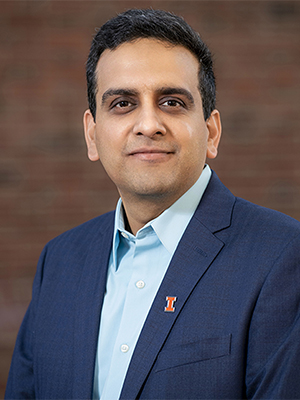Gies Business study: Corporate mobility a positive sign for investors
Aug 4, 2025, 08:00 AM By
A trading strategy that prioritizes central firms in the employee-migration network earns 5.5% per year in abnormal returns.
Investors are always looking for an edge. A new study from Gies College of Business may provide the latest valuable data about how talent movement can influence investment returns. Gies Business professors Gautam Pant and Shagun Pant analyzed more than 140,000 LinkedIn accounts from Standard & Poor’s 500 firms to track career movement. They found that companies situated at the crossroads of employee movements provided a better return for investors.

“When people move, they also bring with them ideas, skills, soft information, or just styles of working they’ve picked up from where they have been,” said Shagun Pant (right), a teaching associate professor of business administration. “That can be beneficial for a firm that is essentially a hub in this network. That hub can benefit from that aggregation of all the information, knowledge, and creativity that people can bring.”
Specifically, the study – “Human capital migration networks and stock returns” – revealed that a portfolio based on a company's inter-firm human capital migration network centrality (HCMNC) yields an annualized 5.5 percent higher return for investors. The research team of Gautam and Shagun Pant, Eric McKee from West Texas A&M University, and Yuanyang Liu from the University of Tennessee published its findings in Review of Financial Economics.
Their findings indicate that the connection is not from CEOs or the Board of Directors, but instead from rank-and-file employees.
“That is the type of information that is subtle and often ignored,” said Gautam Pant, a professor of business administration. “Even though it’s not hard to analyze, it can easily get lost while you are focusing on seemingly more significant numbers.”
LinkedIn data that were downloaded in 2016 allowed the authors to trace employee movements from 2001-2015 and test stock performance from 2011-2017. The final network spans 1,185 US public companies, which goes well beyond the original S&P 500 set.
“I think what’s unique about this new angle is that CEO or Board of Directors movement is relatively rare because they don’t move that often,” Shagun Pant said. “However, rank-and-file employees move more frequently, so we have a much richer network. Because the sheer numbers are larger, we can find links at this level that you wouldn’t be able to find at the CEO or CFO level.”
“On the network side, we looked at the whole profile of an individual,” Gautam Pant said. “We can see, for example, that this person was working at IBM and started working at Microsoft. That allows for making links between firms. Once you take these links over a period, you get hundreds of thousands of these links appearing, and through that, we can create this web of firms.”
The PageRank algorithm was first used by Google as a network of navigation, which revealed where internet users are entering a page from and where they go from there. This helps to provide consumers with a ranking of pages in their searches. Instead of tracking web traffic, this study is using PageRank to track human capital movement across firms. Just as Google measures a website’s importance by examining its connections, the researchers used the algorithm to measure a company’s centrality by tracking the origins of its new hires. Where talent comes from, like incoming web traffic, is critical information.

“We wanted to model the knowledge flow that is taking place and understand the hubness or centrality,” Gautam Pant (right) said. “In the same way that Google notes popular pages are linked by other popular pages, the same is true for human capital movement between firms. In our case, a firm is central if a lot of people from other central firms are moving to it.”
“We tracked the performance of a particular simulated portfolio over time, and even after accounting for several known risk factors, we found abnormally positive returns for this long-short portfolio,” Shagun Pant said.
Although the study is recent, the research offers actionable insights that should be of interest to analysts and investors alike.
“We’re revealing a certain market signal that has essentially not been priced in,” Gautam Pant said. “PageRank has a cyclical definition, which you can solve mathematically. That is one of the things applied here from Google’s initial innovation. In the paper, we describe the techniques we used to make our conclusions. The data itself (information on publicly available LinkedIn pages) is not that hard for firms to find. Hedge funds with an army of researchers can take new data and use the algorithm to get updated results.”
“Implication wise, investors can rank firms every year based on the proposed centrality measure in the human capital movement network. Firms that rank higher are essentially more central and firms that rank lower are less central,” Shagun Pant said. “Investors can then create a trading strategy where they buy stocks that are high in centrality while short-selling stocks that have a lower ranked centrality. While the LinkedIn data is available, no one has aggregated it and constructed the PageRank measure for each firm to look at this trading strategy.”
